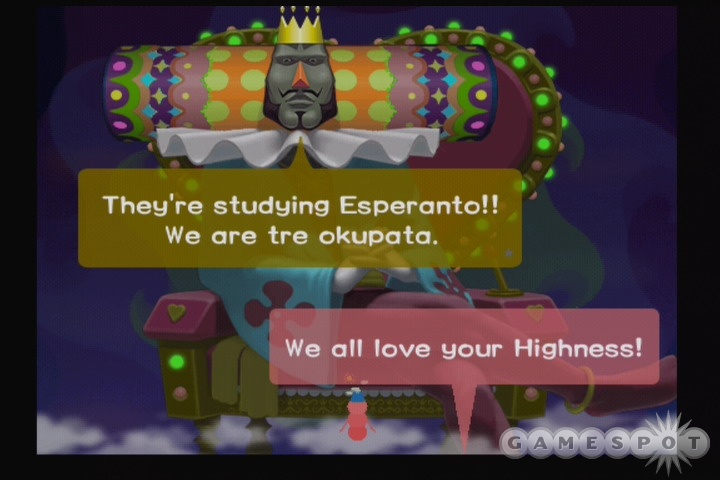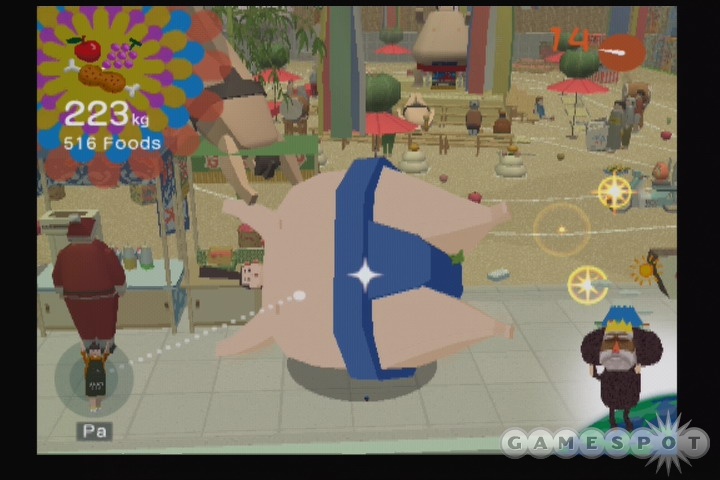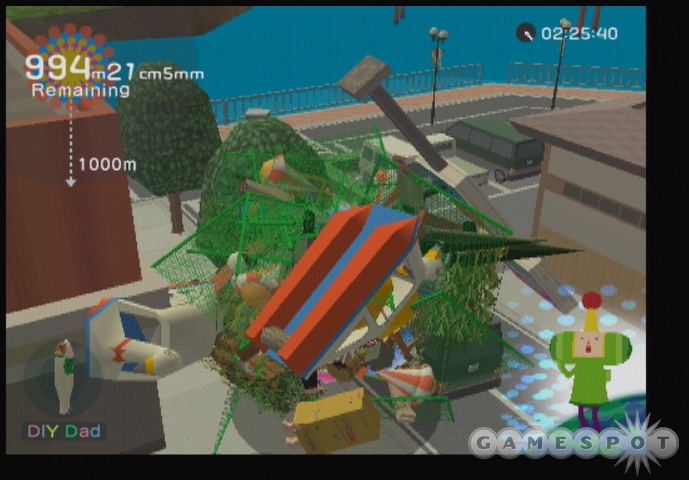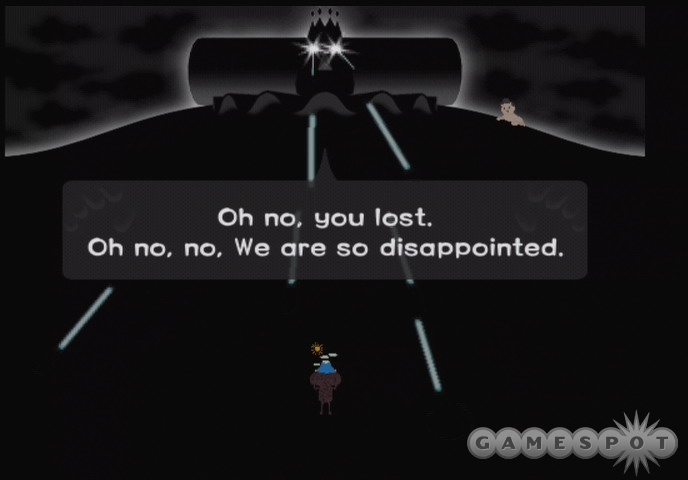How do you follow up on one of the most original and bizarre games of this console generation? That was the question posed to Namco following the incredible success of its out-of-left-field hit puzzler, Katamari Damacy. It was a delightfully simple and effective game that caught on big with a fanatical cult audience, thanks not just to its addictive gameplay, but also to its outlandishly weird dialogue and characters. So, how does Namco follow up on something so patently original? The answer comes in the form of We Love Katamari, a decidedly fan-service-oriented sequel that doesn't stray far from the roots the original game laid down. Rather, it offers a beefier package of the same basic concepts that fans fell in love with the first time around. While it may not deliver on the same level of originality that made Katamari Damacy stand out so clearly, We Love Katamari still has that unmistakable charm, and it's a whole lot of fun, to boot.

Katamari Damacy put you in the role of the pint-sized Prince of all Cosmos. Charged with the impossibly major task of replacing all the stars in the sky that were lost by your eccentric (and possibly drunk) father, the King of All Cosmos, you were given a katamari (essentially a big, sticky ball that attaches itself to anything it rolls over), as well as a size and a time limit, and you were sent into the world, free to roll up any strange object that crossed your path. Whereas the original Katamari Damacy at least made vague allusions to having a cohesive storyline, We Love Katamari unapologetically revels in its own extraneousness. The setup for this latest session of clump-rolling is that the people of Earth had become downright obsessed with the enigmatic King and his katamaris. Eagerly, they show their affection for King and katamari by making all sorts of requests for demonstrations of the katamari's power, and by generally feeding the King's ego with many, many compliments. The King, being ever the crowd-pleaser, is always happy to oblige the affectionate earthlings, and so he puts the Prince (and this time, his many, many cousins) to work, demanding even bigger and more exciting katamaris than ever before.
If you think about it, the plot is pretty hysterical, since it's clearly the developers of the game reacting to Katamari Damacy's sudden popularity. The King and Earth's denizens even openly refer to the previous adventure as "the Katamari Damacy game," so it's pretty clear that they aren't going for anything more than simply quenching the thirst of the fans of the original. It's like a big inside joke that really isn't all that inside, and it works just fine, really. You get all the same charming quirks of the original, with the crazy Lego-esque art style, the wacky soundtrack, and the King himself, who is now even more self-obsessed and utterly incomprehensible in his thought processes. He still takes your katamaris and flings them into the cosmos to make new celestial bodies. And it's not because he has to now, it's simply because it suits his fancy, as well as his adoring public. The game does also interject a bit of backstory into the whole endeavor through several cutscenes that appear in between some levels. They document the King's rise from what one could go so far as to call an abusive childhood, to finding the love of his life, and eventually bringing the beloved Prince into this world. Though none of it exactly ties into the rest of what's going on, these scenes are nothing short of hysterical, and they easily provide the best comedy the game has to offer--which is saying something, since the bulk of the game really is quite funny.
From a gameplay standpoint, anybody who played Katamari Damacy won't have a hint of trouble picking up the sequel. You know the part where you roll the ball around an environment to get it bigger and bigger until time's up? Well you still do that, and you do it pretty much exactly the same way. We Love Katamari employs the same tanklike controls of the original, which require you to move the two analog sticks forward, backward, and from side to side to get your roll on. All the same mechanics, like the speed burst and the Prince's (or whichever character you're controlling--we'll get to that in a second) ability to free look around his surroundings, are intact.

Most of the core changes are at the stage objective level. There are still plenty of stages that simply plop you down in a world and require you to roll up as much of it as possible. But now there are also quite a few more themed stages--areas that ask for more specific work on your part. One, for instance, replaces your standard katamari with a sumo wrestler, and your goal is to roll up as much food for him as possible to make him larger, and thus more threatening to his next opponent (who you must roll up to complete the stage). Another puts you on a racetrack with a katamari, which never stops moving, along with a whole host of wacky racers (even though there's no actual race to be won--you just roll everything up a hell of a lot faster than usual). Another still requires you to roll up all the countries on the planet to make a katamari big enough to stop a giant asteroid that's headed on a collision course with Earth. So, in short, these stages are completely bonkers, but their addition adds a lot of variety to the tried-and-true Katamari Damacy formula, not to mention even more humor value.
Another boost to the breadth of the game involves the dual objectives for each stage. When you first play any basic, ungimmicky level, your objective will be to roll up the biggest katamari you can in a set amount of time. However, once you've completed this objective, a new version of the level will then open up, asking you to reach a certain size in the quickest amount of time possible. As with the last game, if you fail to impress the King by going above and beyond the call of duty, he'll deride you for your lackluster effort yet still accept your mediocre katamari. If you fail altogether, he'll fly off the handle with a lengthy tangent, all the while shooting beams at you from his laser eyes. Oh, did we forget to mention that the King of All Cosmos has laser eyes now? Anyway, such derisions and laser spankings are clear inspiration to go through and play levels multiple times in hopes of reaching higher marks and ultimately pleasing the King. Also, having multiple missions for many of the stages gives you quite a bit of replay value.
That's a good thing, because We Love Katamari is neither an especially challenging nor lengthy endeavor. Going through every available stage (including the ones with dual objectives) probably takes about an hour or two longer than the last game did. But again, the point isn't just to go through every level once, but rather to try to get the best scores possible, which will take plenty of tries. It just isn't especially hard to meet the relatively modest marks of completion the King sets for you before each stage. And the thing of it is, you'll want to go back and play the stages over and over again because they're just that much fun.
The whole tone of We Love Katamari is that of fan service, and as such, the way in which you get your missions in the game is to wander about Earth, talking to the various fans who want their own katamaris rolled up for purely abstract reasons. As you play through the game, you'll be able to collect not only presents, but also different cousins of the Prince, who can be accessed and played as via this hub world. The cousins you unlock will simply wander about the area, and all you need do is walk up to one, press a button, and you'll become that cousin. Unsurprisingly, the different cousins all look like bizarre variations of the Prince, but fundamentally, they all play the same. These cousins come into play mostly for the game's multiplayer modes.
Katamari Damacy featured a versus play mode that was serviceable, but not exactly anything to write home about. We Love Katamari includes a marginally better versus mode, as well as cooperative play for two players. The versus mode is essentially the same kind of split-screen action found in the first game, but with three levels available to you, as well as a different objective: find the most of a specific item and roll it all into your katamari. It's not a bad mode, and the addition of a target-lock feature makes it a bit easier to locate your opponent (who you can then hopefully slam into) on the map. However, the lack of variety hurts the mode's replayability.
As for the co-op, pretty much every stage in the game can be played cooperatively. The cooperative mechanics effectively restrict the equivalent of one of the analog sticks to one controller, meaning you both need to move both sticks in the same direction in order to move the katamari. It's pretty confusing at first, but if you and your partner can communicate effectively, it can eventually become quite a bit of fun to roll that crazy clump around together, making for a pretty good party game. It's unfortunate that in this mode, Namco apparently removed the onscreen display that showed the direction in which each player's sticks were moving. This feature is present in the Japanese version of the game, but was apparently axed for the North American release.
We Love Katamari retains the same contrastingly square graphical style of the first game. Most objects, people, and really, pretty much everything, have a decidedly angular look to them. And despite the fact that the look of the game hasn't really changed much, it's still impressive, simply because of how bizarre it all is. Stages are almost the same as they were before, with seemingly arbitrary strings of nonsensical objects laid in particularly painstaking patterns all across the world. Again, you don't know why long rows of harps are sitting in the middle of the street, or why a matador and a boxer are guarding a school playground. But you don't need to know, because within the context of the game's oddball universe, it all makes some preposterous measure of sense. We Love Katamari also maintains a better frame rate than its predecessor, and it features a better camera that frequently creates a hole through objects that otherwise might block your field of view. Unfortunately, the camera isn't all that consistent about this, so there are random intervals where you'll still get walls and similarly blunt objects blocking your vision.

One of the most memorable aspects of Katamari Damacy was its utterly avant-garde soundtrack, featuring tracks that ran the gamut between swing, techno, J-pop, and just about anything else you could imagine. We Love Katamari contains yet another completely off-the-wall soundtrack that has the same key themes as the first game. The main theme song pops up in multiple forms and genres throughout the game, with the best of the bunch coming in the form of a lounge singer that vaguely resembles a Japanese Tom Jones. But apart from that, there's more electro, J-rock, and other kooky songs to enjoy throughout the game. It has to be said that We Love Katamari's soundtrack is decidedly less focused on catchiness than its predecessor's was, and instead it moves in the experimental direction, which makes for an occasionally more cacophonous experience. But noise experiments aside, the whole thing is easy to listen to, even when it's trying its best not to be overly catchy. The rest of the sound design runs pretty similarly to that of the first game. There's no dialogue, save for the record-scratching sound effects that comprise the King of All Cosmos' voice and the indecipherably goofy cries of the fans. The in-game sound effects might as well be the same ones as those that were in the first game. It's all excellent stuff, though.
In the end, We Love Katamari is basically just a big, happy love letter to the fans that contributed to the first game's success. Namco clearly had no intention of mucking up a winning formula, and as such, it has created a sequel that delivers more of the same fetchingly enjoyable gameplay and whimsical humor that made Katamari Damacy so much fun. Undeniably, We Love Katamari lacks the consummate originality of the first game, but for most, the lack of originality won't be a hindrance. And anybody who played and enjoyed Katamari Damacy will feel right at home with the sequel.




